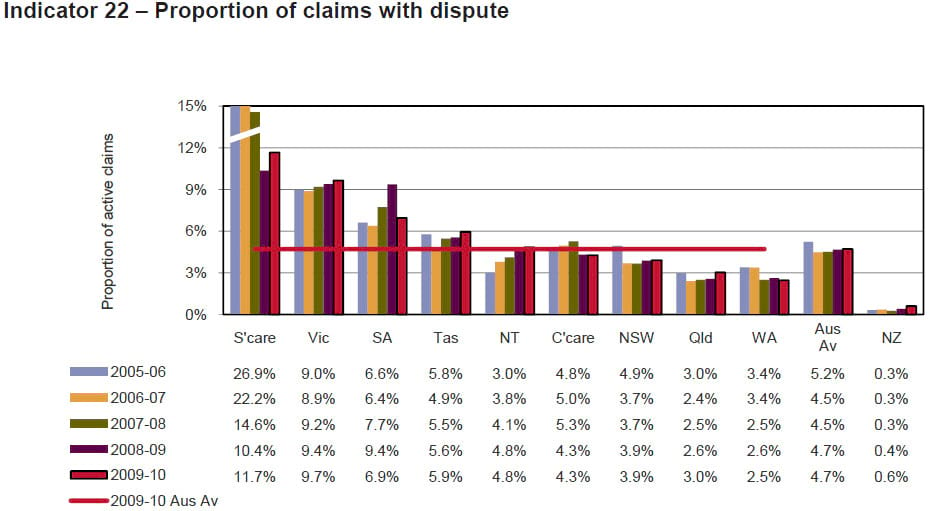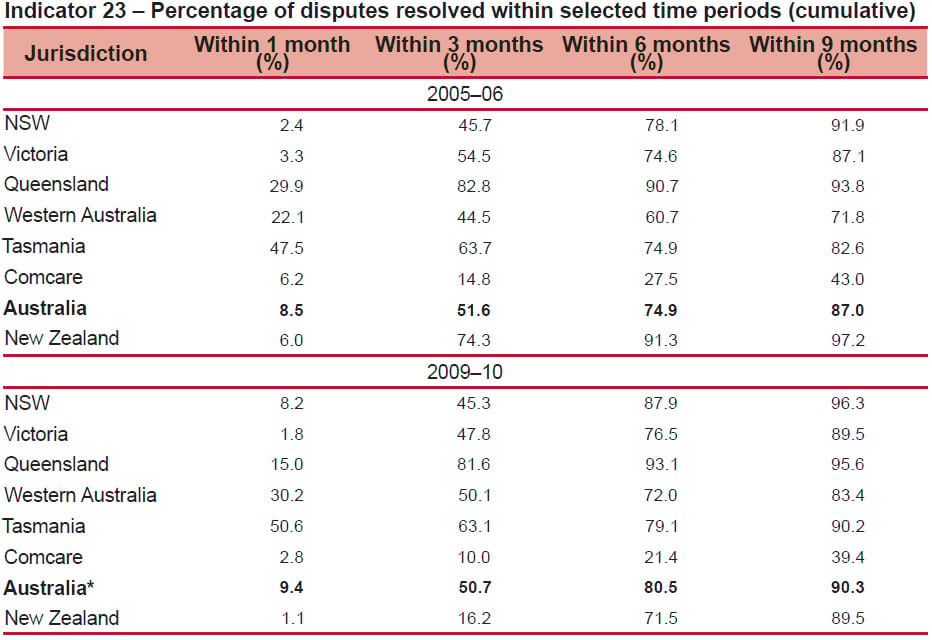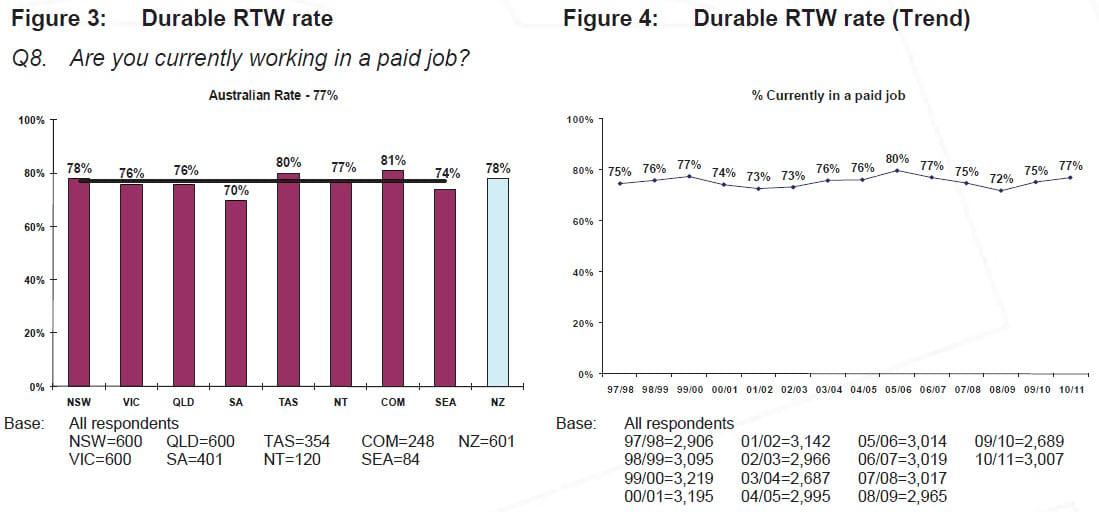Consider the alternative: Part 3 - Victoria

New to this series on the use of dispute resolution in the context of workers' compensation disputes? Previous articles in this series include:
- Part 1 – An Introduction to Alternative Dispute Resolution
- Part 2 – What makes a good ADR system with Nerida Wallace, Principal of Transformation Management
VICTORIA BY THE NUMBERS
Disputation rate

Data taken from Workplace Relations Minister's Council Comparative Performance Monitoring Report (October 2011) (p. 38)
Victoria’s disputation rate of 9.7% was by far the largest of any State or Territory (South Australia second highest with 6.9%), and over twice the national average of 4.7%. The rate can be attributed to a number of things, but as Nerida Wallace of Transformation Management explains, “what the disputation rate tells you is how the insurers are performing in making the initial decision”.
Resolution rate

Data taken from Workplace Relations Minister's Council Comparative Performance Monitoring Report (October 2011) (p. 38)
In 2009-10, Victoria’s resolution rates were below the national average for each of the 1,3,6 and 9 month periods. The 1 and 3 month rates were down from 2005-06, while the 6 and 9 month rates improved.
Durable RTW rate

Table from Heads of Workers' Compensation Authorities RTW Monitor 2010/11 (p. 2)
Victoria’s 2010-11 durable RTW rate of 76% was marginally lower than the national average of 77%.
THE VICTORIAN SYSTEM
Victoria’s system involves a combination of internal review, conciliation and litigation in either the Magistrate’s or County Courts :
-
Advice – employees or employers who have questions or concerns about work safety may contact the WorkSafe Victoria Advisory Service (phone: 1800 136 089 or: (03) 9641 1444, email: info@worksafe.vic.gov.au) and obtain free advice about their rights and/or responsibilities. Alternatively, union members may contact Union Assist, run by the Victorian Trades Hall Council (phone: (03) 9639 6144, email: info@unionassist.org.au) which also provides free advice.
-
Review – If either an employee or employer doesn’t agree with an initial claims decision, they can request an internal WorkSafe Agent review. This review will be carried out by “a senior person within the WorkSafe Agent who was not involved in the original decision.
-
Conciliation – The only use of ADR in Victoria, parties who are dissatisfied by the review can make a request to the Accident Compensation Conciliation Service within 60 days or receiving the decision with which they disagree.
-
Once the ACCS has set a date for the Conciliation, a ‘WorkSafe Consultant’ will be allocated to assist the party through the process (i.e. provide general information, investigate the possibility of pre-conference settlement - if requested), attend the scheduled 90 minute Conference with you).
-
Once the ACCS has set a date for the Conciliation, a ‘WorkSafe Consultant’ will be allocated to assist the party through the process (i.e. provide general information, investigate the possibility of pre-conference settlement - if requested), attend the scheduled 90 minute Conference with you).
- Litigation – If Conciliation fails to produce a decision and the conciliation officer believes there is a ‘genuine dispute’, the parties may take their case to either the Magistrate’s (claims up to $100,000) or County Courts (all other claims).
What happens at the Conciliation Conference?
In the room, the Conciliation Officer's goal is to help the parties help themselves.
What the Conciliation Officer does
-
Explains how the discussion will take place as well as a number of 'ground rules' intended to allow each party to have their say (i.e. no interruptions when the other party is speaking);
-
Clarifies all relevant issues in dispute (i.e. extent of injury, whether it is a 'work' injury);
-
Ensures that all relevant documentation (i.e. medical reports) is tabled and discussed so that each party understands what they say and what they mean;
-
Asks questions to each party to ensure they understand the implications of taking a position or potential course of action (i.e. refusing an offer with uncertainty surrounding their case in litigation);
-
Speaks with parties separately if there are issues that one or both sides might feel uncomfortable discussing in the presence of the other (i.e. money problems); and
-
Makes an impartial assessment of all issues and offers suggestions about how parties could reach an agreement.
What the parties do
-
State their view on the situation clearly and concisely;
-
Listen to the other party;
-
Seek clarification or further information if they do not understand something; and
-
Suggest and consider options for resolving the dispute.
What the parties discuss
The parties discuss all issues in dispute, with common points of difference including:
-
The nature or severity of the injury;
-
The cause of the injury (whether it can be medically proven that the injury was sustained on the job);
-
What earnings were lost as a result of the injury (i.e. predicting likely earnings for casual employees); and
-
The likely period of inability to work after surgery.
The possible outcomes
Agreement - the Conciliation Officer helps finalises details on the day, and later sends out a certificate that outlines what both parties have agreed to, and that the agreement is binding.
Recommendation - if parties are unable to reach an agreement on their own, the Conciliation Officer may offer a recommendation as to how one could be reached. Parties may then accept.
Adjournment - where necessary, the Conciliation Officer can adjourn the conference to seek further information, or refer a medical question to a Medical Panel
No Agreement - if the parties fail to come to an agreement and reject the Conciliation Officer's recommendation, the Officer then assesses the merit of the claim:
-
If no arguable case for denying payment - they can provide a direction that weekly payments or medical expenses may be given; or
- If an arguable case for denying payment - and the Officer believes that the person making the claim has taken 'all reasonable steps to settle the dispute, a certificate may be issued, allowing the party making the claim to proceed to litigation.
Source: Victorian Accident Compensation Conciliation Service website.
HOW THEY ARE MAKING IT BETTER
The Hanks Report and Subsequent Reform
In December 2007, the Victorian Government commissioned Peter Hanks QC to review the Victorian workers’ compensation system. In 2008, Mr Hanks delivered the ‘Hanks Report’, which set out over 150 recommendations for reform.
In 2009, rejecting Hanks' recommendation of creating a new Act, the Government introduced a Bill of around 250 pages to amend existing legislation covering the area (i.e. Accident Compensation Act 1985). The majority of the changes came into effect on or before 5 April of last year.
The changes were substantial, broadly impacting on return to work, benefit entitlements and the level of employer obligations. Overall, the Act comes across as more aspirational than it was prior to the reforms. Key changes include:
-
New employee protections against discrimination by employers when pursuing a claim;
-
Simplifying employee obligations with respect to their return to work, introduction of a 'staged approach' to non-compliance that according to WorkSafe Victoria "give[s] injured workers fairer warning of penalties that might be imposed for failing to comply with their return to work obligations"; and
- Expanded powers for 'return to work inspectors' (who investigate and follow up non-compliance and provide information), including the ability to issue 'improvement notices' to employers (similar to OH&S notices).
The Hanks Report proposed a number of changes to how ADR/the ACCS operates, specifically the introduction of statutory timeframes to improve efficiency. The majority of these were rejected. Changes that were supported by the Government included:
- Providing for reimbursement of reasonable travel expenses and related time lost from work for workers attending conciliation; and
- Increasing the powers of the Senior Conciliation Officer to promote consistency, transparency and accountability in conciliations.
Return To Work
Return to work was highlighted as a crucial issue by Mr Hanks. In discussing the areas for reform in his report, Mr Hanks said “improving return to work is the central objective”. Hanks said a key focus was changing the way that return to work duties are expressed, looking to bring them in line with OH&S legislation.
Under s194 of the amended Accident Compensation Act, employers will be required to do the following, to the extent that it is reasonable to do so:
- return employees to work where they have a partial or complete capacity to do so (for a period equal to 52 weeks following their first notification of a claim);
- plan the return to work of a worker;
- consult with the worker regarding the return to work;
- nominate a return to work coordinator; and
- make a return to work plan available.
The Victorian Trades Hall Council has expressed concerns that, owing to the 'reasonableness' qualification, that there is some question about how comprehensive these 'requirements' are. Citing s195(1) of the Act, the Victorian Trades Hall Council says that “the requirement that an employer plan a worker’s return to work does not appear mandatory but rather must be done ‘to the extent that it is reasonable to do so’ from the date of the worker’s incapacity” (emphasis added).
However the changes essentially up the ante on employers, with obligations potentially commencing as early as when an employee receives a medical certificate and requires employers to get more involved in the development of return to work programs.
Overall the changes aim to bring about a more consultative relationship between the injured worker and their employer, and remove unnecessary complexity. According to WorkSafe Victoria the changes will "cut red tape for employers by reducing the emphasis on complex processes and paper compliance." This is an obvious win for employers dealing with short-term injuries, but time will tell whether less documentation will be an issue for those trying to prove ongoing compliance to a RTW program when dealing with a long-term case.
THE BOTTOM LINE
With an exceptionally high disputation rate (relative to the rest of the country), the quality of Victoria's workers' compensation system takes on an ever higher level of importance. Whatever the numbers say, there was enough political will in Victoria for a comprehensive review and reform agenda to play out, so the desire to improve was there. Whether or not the changes have a significant impact on the quality of outcomes will take some time, as all parties adjust to the new (and in some cases considerable) obligations.
Although a number of the proposals about reforming the Conciliation process were rejected, there was still great news for return to work in Victoria. The fact that Hanks went so far as to say that improving RTW was his “central objective" (and the fact that his sweeping changes were accepted) speaks to the growing support it enjoys in the political arena.

